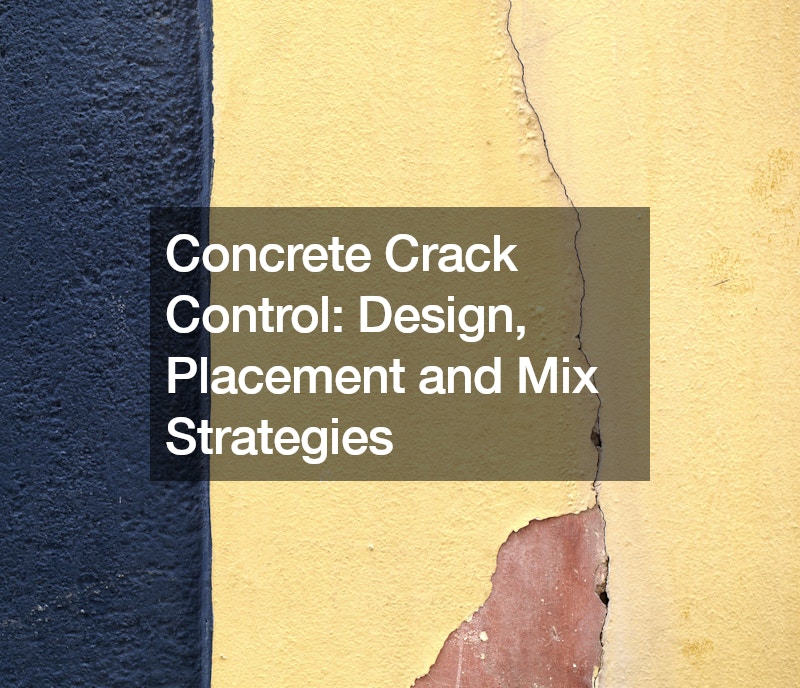

Cracks in concrete are a common sight, and while they may not always affect the structural integrity, they can be unsightly and allow water ingress, leading to future problems. The good news is that cracks can be minimized through careful design, proper placement techniques, and a well-considered concrete mix. This article explores these strategies for achieving a smooth, durable concrete finish.
Understanding the Cause of Cracks
Cracks in concrete form due to tensile forces, which pull the material apart. Concrete is strong in compression but weak in tension.
These tensile forces can arise from various sources:
- External stresses: Loads placed on the structure, such as bending or shearing, can induce tensile forces at specific points. For example, a slab supported on two ends will experience tensile forces on the bottom surface near the center.
- Internal factors: As concrete cures and dries, it shrinks. If this shrinkage is restrained, internal tensile forces develop, leading to cracks. This shrinkage can be caused by the chemical reactions during hydration (the process by which concrete hardens) or simply by the loss of moisture from the concrete.
Design Strategies for Crack Control
The design phase plays a crucial role in minimizing cracks. Here are some key strategies:
- Joint Planning: Strategically placed joints act as predetermined breaking points, allowing the concrete to move and crack in a controlled manner. The spacing and location of joints depend on the size and shape of the concrete element, as well as the anticipated stresses. Proper joint design helps prevent uncontrolled random cracks from forming elsewhere in the structure.
- Reinforcement: Steel rebar embedded within the concrete acts as a tension-resistant skeleton. By taking on the tensile forces, the rebar helps prevent the concrete itself from cracking. The size, spacing, and layout of the rebar are crucial considerations during the design stage.
- Limiting Restraint: When possible, the design should minimize restraints that could impede the natural shrinkage of the concrete. This might involve incorporating expansion joints or designing elements with fewer rigid connections.
Placement Techniques for Minimizing Cracks
Once the design is finalized, proper placement techniques are essential to ensure the concrete performs as intended:
- Proper Compaction: Inadequate compaction can lead to weak spots and uneven shrinkage, increasing the risk of cracking. Proper vibration during placement ensures a dense and uniform concrete mix, minimizing voids and promoting even strength throughout the element.
- Curing: Curing is the process of keeping the concrete moist during its early stages of hardening. This prevents rapid drying, which can cause excessive shrinkage and cracking. Curing methods can include water spraying, covering the concrete with wet burlap, or applying curing compounds.
Mix Design Strategies for Crack Control
The concrete mix itself also plays a significant role in crack control. Here are some key considerations:
- Water-Cement Ratio: The water-cement ratio (W/C) is the ratio of the weight of water to the weight of cement in the mix. A lower W/C ratio results in a stronger and less crack-prone concrete. This is because less water means less shrinkage as the concrete dries. However, a very low W/C ratio can make the concrete difficult to work with. Finding the optimal balance between strength and workability is crucial.
- Aggregate Selection: The type and size of aggregate (sand, gravel, etc.) used in the mix can influence cracking. High-quality, well-graded aggregates with a low potential for shrinkage are preferred. Additionally, using larger aggregate particles can reduce the overall shrinkage of the mix.
- Admixtures: Certain admixtures can be added to the concrete mix to improve its properties and minimize cracking. Some admixtures can slow down the hydration process, allowing for more controlled shrinkage. Others can improve workability, allowing for a lower W/C ratio without sacrificing ease of placement.
The Importance of Early Intervention
Despite taking all necessary precautions, some degree of cracking might still occur in concrete. Early detection and repair of cracks are essential to prevent them from growing and compromising the structural integrity. Regularly inspecting concrete surfaces for signs of cracks is crucial.
Hairline cracks may be purely aesthetic concerns, but larger cracks need to be addressed promptly. For significant cracks, consulting with a structural engineer or concrete repair service is recommended. They can assess the severity of the crack and recommend the most appropriate repair method. Concrete repair services offer a variety of techniques for repairing cracks, depending on the size, location, and severity of the issue.
By implementing a combination of design strategies, proper placement techniques, and a well-considered concrete mix, the likelihood of cracks in concrete structures can be significantly reduced. However, it’s important to remember that concrete will naturally experience some degree of shrinkage and movement. Early detection and repair of any cracks that do appear will help ensure the longevity and functionality of the concrete structure.
.
